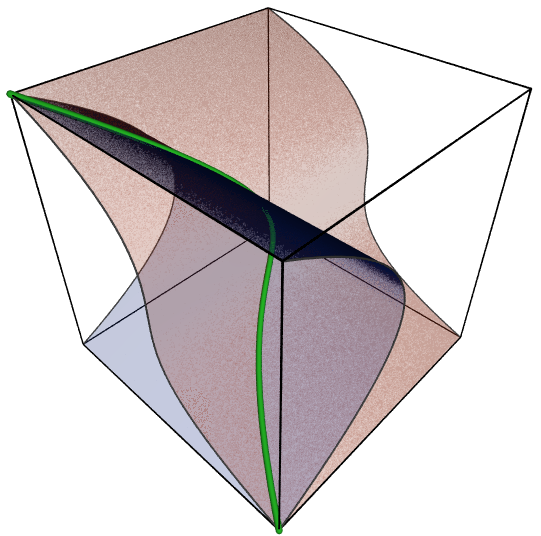|
Infinitesimal Cohomology
In mathematics, infinitesimal cohomology is a cohomology theory for algebraic varieties introduced by . In characteristic 0 it is essentially the same as crystalline cohomology In mathematics, crystalline cohomology is a Weil cohomology theory for schemes ''X'' over a base field ''k''. Its values ''H'n''(''X''/''W'') are modules over the ring ''W'' of Witt vectors over ''k''. It was introduced by and developed by .... In nonzero characteristic ''p'' showed that it is closely related to etale cohomology with mod ''p'' coefficients, a theory known to have undesirable properties. References *. *. * Algebraic geometry Cohomology theories {{algebraic-geometry-stub ... [...More Info...] [...Related Items...] OR: [Wikipedia] [Google] [Baidu] |
Cohomology Theory
In mathematics, specifically in homology theory and algebraic topology, cohomology is a general term for a sequence of abelian groups, usually one associated with a topological space, often defined from a cochain complex. Cohomology can be viewed as a method of assigning richer algebraic invariants to a space than homology. Some versions of cohomology arise by dualizing the construction of homology. In other words, cochains are functions on the group of chains in homology theory. From its beginning in topology, this idea became a dominant method in the mathematics of the second half of the twentieth century. From the initial idea of homology as a method of constructing algebraic invariants of topological spaces, the range of applications of homology and cohomology theories has spread throughout geometry and algebra. The terminology tends to hide the fact that cohomology, a contravariant theory, is more natural than homology in many applications. At a basic level, this has to do ... [...More Info...] [...Related Items...] OR: [Wikipedia] [Google] [Baidu] |
Algebraic Variety
Algebraic varieties are the central objects of study in algebraic geometry, a sub-field of mathematics. Classically, an algebraic variety is defined as the set of solutions of a system of polynomial equations over the real or complex numbers. Modern definitions generalize this concept in several different ways, while attempting to preserve the geometric intuition behind the original definition. Conventions regarding the definition of an algebraic variety differ slightly. For example, some definitions require an algebraic variety to be irreducible, which means that it is not the union of two smaller sets that are closed in the Zariski topology. Under this definition, non-irreducible algebraic varieties are called algebraic sets. Other conventions do not require irreducibility. The fundamental theorem of algebra establishes a link between algebra and geometry by showing that a monic polynomial (an algebraic object) in one variable with complex number coefficients is det ... [...More Info...] [...Related Items...] OR: [Wikipedia] [Google] [Baidu] |
Crystalline Cohomology
In mathematics, crystalline cohomology is a Weil cohomology theory for schemes ''X'' over a base field ''k''. Its values ''H''''n''(''X''/''W'') are modules over the ring ''W'' of Witt vectors over ''k''. It was introduced by and developed by . Crystalline cohomology is partly inspired by the ''p''-adic proof in of part of the Weil conjectures and is closely related to the algebraic version of de Rham cohomology that was introduced by Grothendieck (1963). Roughly speaking, crystalline cohomology of a variety ''X'' in characteristic ''p'' is the de Rham cohomology of a smooth lift of ''X'' to characteristic 0, while de Rham cohomology of ''X'' is the crystalline cohomology reduced mod ''p'' (after taking into account higher ''Tor''s). The idea of crystalline cohomology, roughly, is to replace the Zariski open sets of a scheme by infinitesimal thickenings of Zariski open sets with divided power structures. The motivation for this is that it can then be calculated by taki ... [...More Info...] [...Related Items...] OR: [Wikipedia] [Google] [Baidu] |
Algebraic Geometry
Algebraic geometry is a branch of mathematics, classically studying zeros of multivariate polynomials. Modern algebraic geometry is based on the use of abstract algebraic techniques, mainly from commutative algebra, for solving geometrical problems about these sets of zeros. The fundamental objects of study in algebraic geometry are algebraic varieties, which are geometric manifestations of solutions of systems of polynomial equations. Examples of the most studied classes of algebraic varieties are: plane algebraic curves, which include lines, circles, parabolas, ellipses, hyperbolas, cubic curves like elliptic curves, and quartic curves like lemniscates and Cassini ovals. A point of the plane belongs to an algebraic curve if its coordinates satisfy a given polynomial equation. Basic questions involve the study of the points of special interest like the singular points, the inflection points and the points at infinity. More advanced questions involve the topo ... [...More Info...] [...Related Items...] OR: [Wikipedia] [Google] [Baidu] |

